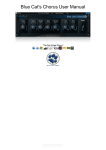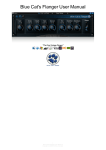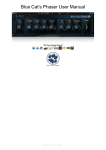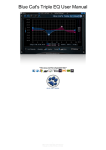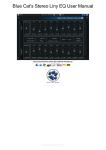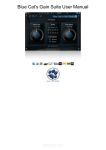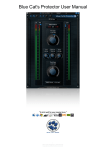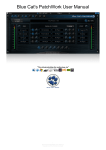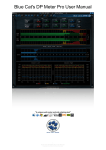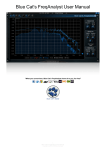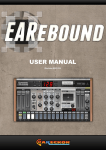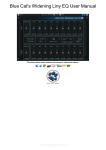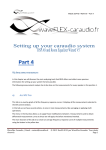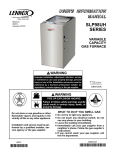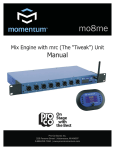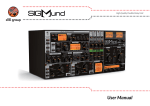Download Blue Cat`s Liny EQ User Manual
Transcript
Blue Cat's Liny EQ User Manual
"Linear phase equalization, without the latency."
1
Blue Cat's Liny EQ User Manual
Copyright (c) 2005-2014 Blue Cat Audio
Table Of Content
Introduction
Description
Features
System Requirements
Installation
Using Blue Cat's Liny EQ
Introduction
The User Interface
Operation
Blue Cat Audio Plugins Basics
User Interface Basics
Controls
Keyboard
Mouse
Presets Management
MIDI & Automation Control
More
Blue Cat's Liny EQ Parameters
Plug- in Settings
The Global Settings Window
The Preset Settings Window
About Skins
Changing the Skin
Create a Custom Skin
Frequently Asked Questions
More
Extra Skins
Tutorials
Updates
Versions History
Note: An online version of this user manual is available here.
2
Blue Cat's Liny EQ User Manual
Copyright (c) 2005-2014 Blue Cat Audio
Note: An online version of this user manual is available here.
Introduction
Description
Blue Cat's Liny EQ is an 8 bands linear phase equalizer with very low latency and comprehensive visual feedback: thanks to its
highly optimized linear phase kernel, it processes the signal without phase distortion, with an unusually short latency (less than 3
milliseconds).
Its wide range of gain (+-40dB) and multiple filter shapes make it very flexible for a graphic EQ, letting you create unique EQ
curves. The dual channels version offers independent settings for the left/ right or mid/ side channels, with flexible linking
capabilities for an optimal workflow.
The highly customizable user interface includes a first class spectrum analyzer and spectrogram viewer. It lets you choose the best
layout and display options to adapt the plug- in to your own workflow.
Thanks to its ability to update the EQ curve continuously using MIDI or automation and its additionnal "Mix" control, dynamic
equalization tasks can be performed easily when used together with any of our control generation plug- ins.
Typical applications: Low latency linear phase equalization, mastering, mixing, spectral correction, stereo widening or narrowing.
Features
Main Features:
Blue Cat Audio Standards:
Linear phase graphic equalizer
Available as: Mac- AAX, Mac- AU, Mac- RTAS, Mac- VST, Win-
very short latency (less than 3 ms: 128 samples at 44,1 kHz), with
minimal pre- ringing artefacts.
customizable range (+/- 40 dB).
Exact EQ curve display.
Four EQ shapes.
AAX, Win- DX, Win- RTAS, Win- VST, Win x64- AAX, Win x64DX, Win x64- VST.
Native DSP code for optimal performance.
Full MIDI control and automation support with silent, zipper- free
parameters update, advanced response control and MIDI Learn.
Automatic gain compensation.
Real time spectrum analyzer display.
High resolution color and greyscale spectrogram display.
High resolution color peak meter.
No CPU load on idle: when the plug- in is fed with silence, the
processing smoothly shuts down, to optimize the CPU usage of
your Digital Audio Workstation.
Skinnable and customizable user interface with transparency
Single and dual channel versions.
Left/ right or mid/ side processing for spectral stereo widening or
narrowing.
Advanced channels linking capabilities.
management.
Smooth Bypass: activate/ deactivate the plug- in with absolutely
no noise.
Undo/ Redo.
Multiple display sizes.
Highly customizable user interface: display what you need, the
way you need.
Full featured integrated presets manager.
Copy/ paste the plug- in's state between instances using the
system clipboard.
Any sample rate supported.
System Requirements
Windows
Mac OS X
An SSE2- enabled processor (Pentium 4 or later).
Microsoft Windows XP, Vista, Windows 7 or 8.
Any DirectX / VST / RTAS / AAX compatible host software (32 or
64 bit).
An Intel processor.
Mac OS X Mavericks(10.9), Moutain Lion (10.8), Lion (10.7),
Snow Leopard (10.6), or Leopard (10.5).
Any VST / Audio Unit (32/64- bit) / RTAS / AAX compatible
application.
For more information about supported platforms, see our FAQ.
Installation
Blue Cat Audio plug- ins cannot be run standalone, they require a host application (see the System Requirements chapter for more
information). Depending on which host application you use, you might need to install the plug- ins in different locations.
Windows
Install
3
Blue Cat's Liny EQ User Manual
Copyright (c) 2005-2014 Blue Cat Audio
All versions of the plug- in provide an installation program. Follow the steps of the wizard to install the plug- in on your machine.
During the installation you will be asked where you want the plug- in(s) to be installed. For the VST version you should install the
plug- in inside the VST plug- ins folder used by your host application(s). The default path set in the installer should work for most
applications, but you should check your host software documentation to know where it looks for VST plug- ins.
Some applications will not automatically rescan the new plug- ins, so you might have to force a refresh of the plug- ins list.
Upgrade
When a new version of the plug- in is released, just launch the new installer: it will update the current installation.
Uninstall
To uninstall the plug- in, simply launch the "Uninstall" program that is available in the start menu or in the configuration panel. It will
take care of removing all files from your computer.
Mac
Install
On Mac the plug- ins are available as drive images. After download, double click on the file to open it. You can then drag and drop
the plug- in file(s) to the shortcut that is provided within the image. It will install the plug- in(s) for all users on the machine.
In case you do not have admin rights on your Mac or if you want to install the plug- in(s) to another directory, just copy the files to
the appropriate location. If required, more information is available in the README.txt file that is included in the package.
Upgrade
When a new version of the plug- in is released, open the new image and copy the files over the previous ones. The new version will
replace the older one.
Uninstall
To uninstall the plug- in, simply remove the plug- in components from the folder where you have copied them during install (move
them to the trash).
If you want to completely remove all settings and configuration files, you can also remove these additional directories that may
have been created on your computer:
~/ Library/ Preferences/ Blue Cat Audio/ [Plug- in name and TYPE], where TYPE is VST, AU, RTAS or AAX: global
preferences.
~/ Library/ Preferences/ Blue Cat Audio/ [Plug- in name]: license information
~/ Documents/ Blue Cat Audio/ [Plug- in name]: user data, such as presets, additional skins and user- created plug- in data.
Just beware that these directories may contain user data that you have created. Remove these directories only if you wo not want
to reuse this data later.
4
Blue Cat's Liny EQ User Manual
Copyright (c) 2005-2014 Blue Cat Audio
to reuse this data later.
Using Blue Cat's Liny EQ
Introduction
Blue Cat's Liny EQ is versatile linear phase graphic equalizer with very low latency and minimal pre- ringing artefacts.
Graphic EQ
With a graphic EQ, you can change the gain of a pre- selected set of frequencies that cannot be modified. In this particular plug- in,
the EQ offers several shapes to increase the flexibilty and overcome the limitations that are usually found on such EQs. It is thus
possible to create almost any EQ shape without the need for more control.
Linear Phase
A linear phase EQ is a special type of EQ that does not affect the phase of the signal by introducing a phase shift in the signal that
is proportional to the frequency, as opposed to " minimum phase" EQs. It means that it usually sounds more transparent because it
does not change the shape of the signal with random phase shift accross the spectrum. It's one of the reasons why such EQs are
preferred at the mastering stage.
Latency
Linear phase EQs all bring additional latency to your signal chain, because they add a constant delay to all frequencies (you can
see this as a way to compensate the phase shift). This can become a problem when the latency becomes high, because your
Digital Audio Workstation (DAW) will react with a noticeable delay.
In the case of this plug- in, this is not an issue since the latency has been greatly reduced: it is less than 3 milliseconds (128
samples at 44.1 kHz) thanks to a specially optimized filter kernel. You can thus enjoy your linear phase EQ without the latency!
Pre- ringing
One of the downsides of linear phase equalizers is a "pre- ringing" effect that can be heard on transients: because of the way digital
linear phase EQs affect the phase, some frequencies may be shifted to the "and" and happen before a transient occurs (a kind of
"back to the future" effect). This audible artefact sounds rather unnatural.
The good news is that this effect is highly reduced with Blue Cat's Liny EQ and its very low latency kernel. Even if you tweek low
frequencies, pre- ringing should be barely noticeable.
Mid/ Side?
Blue Cat's Liny EQ offers mid/ side processing capability. With this feature you can process the mid (center) and side (sides)
channels instead of the usual left and right channels.
Concept Origin: Mid/ Side Recording
Mid/ Side recording is a famous recording technique that is preferred in some cases to the traditional left/ right recording. Searching
for "mid side recording" on the web will give you many tutorials about this technique.
The result of such a recording is a pair of mid/ side (M/ S) channels instead of classic left/ right (L/ R) channels in an audio stream.
The mid channel is also often called "Mono" and side "Stereo": the mid channel contains the signal that is in the center of the stereo
mix, and the side channel contains the rest (everything that is on the sides of the mix):
(The triangles above represent the listener's head)
From Mid/ Side Recording to Processing
The relationship between L/ R and M/ S channel can be computed so that you can transform any Mid/ Side recording to standard
listenable left/ right stereo stream. The reverse operation is also possible, which means that you can artificially separate mid/ side
information from your usual L/ R stereo tracks. That's what is done by our mid/ side processing plug- ins.
5
Blue Cat's Liny EQ User Manual
Copyright (c) 2005-2014 Blue Cat Audio
Processing separately the mid/ side channels instead of left/ right channels offers more control over the stereo character of a
sound. Reducing the volume of the side channel makes it sound more "mono" and vice versa.
Mid/ Side and EQ
Applied to EQ, this lets you control how "stereo" a range of frequencies may sound. It offers a much more flexible and intuitive way
of managing the stereo distribution of spectrum than the usual left/ right technique: processing separately both channels does not
alter the L/ R balance of the output signal but changes the ratio between the stereo and mono signals instead. It is thus much
easier to control: you can choose to either "stereoize" or "monoize" parts of the spectrum.
The User Interface
Note: The main toolbar, menus and basic features available with all our plug- ins are detailed in the Blue Cat Audio Plug- ins
Basics section.
Blue Cat's Liny EQ is bundled with several skins that have similar layouts and exactly the same capabilities. The default skin is
described below.
Overview
The plug- in comes in two versions: single channel (one set of controls is available and affects both the left and right channels for
stereo instances), and dual channels (two sets of controls are provided, with left/ right or mid/ side operation).
Both versions are very similar, except that the dual channels plug- in offers more controls, so we will focus on the user interface of
the dual channels plug- in.
1. Layout type for channel controls below the graph: single, dual column or dual row. You can choose if you want only one
channel at a time, or both channels displayed in a column or a row (Dual version only).
2. Show/ Hide EQ controls.
6
Blue Cat's Liny EQ User Manual
Copyright (c) 2005-2014 Blue Cat Audio
2. Show/ Hide EQ controls.
3. Show/ Hide graph.
4. Show/ Hide output level meters (#12).
5. Select the display size to adapt the user interface to your screen.
6. Freeze display: freezes the spectrum or spectrogram display if active.
7. Mid/ Side switch: when activated, channel 1 represents the mid (center, or mono) signal and channel 2 the side (or stereo)
signal. When off, channel 1 is the left channel and channel 2 is the right channel (Dual version only).
8. Link channels: when active, controls for both channels are linked together, according to the options selected with #9 and #10
(Dual version only).
9. Absolute/ Relative link: in absolute mode the values of the controls for both channels are identical, whereas in relative mode
only controls variations are reported to the other channel (letting you setup a different EQ on each channel, and then apply
linked modifications for example).
10. Normal/ Mirror link: in mirror mode, the gain value for both channels are reversed. It is very handy when you want to use the
EQ as a balance between channels (Dual version only).
11. Display range: select the range for the EQ (affects both the controls and the display).
12. Output level meters: display the peak level at the output of the EQ.
13. EQ response curve and controls: the response curve of the EQ is displayed on the graph (decibels as a function of
frequency), and overlayed controls are available to ste the gain for each band. Controls can be hidden using #15.
14. Spectrum analysis display: depending on the options chosen with #16 and #17, a spectrogram or spectrum curve may be
displayed behind the EQ curve.
15. Select for which channels you want to display the controls over the EQ reponse graph.
16. Select for which channels you want the analysis curves to be displayed.
17. Select audio analysis display type (instant spectrum curves, greyscale or color spectrogram).
18. Main gain controls for each channel.
19. Auto gain control for each channel. When "auto gain" is selected, the EQ automatically sets the output gain to compensate
the maximum peaks set on the EQ, so that the signal's maximum boost is kept at 0 dB.
20. Click on the channel name or the arrow to switch controls for the other channel, when single display mode is selected with #1
(Dual version only).
21. Normal or Notch shape for the current channel: see the various EQ modes and shapes in the next chapter for more
information.
22. Smooth or Sharp mode for the current channel: see the various EQ modes in the next chapter for more information.
23. Mix Control for the current channel: this control acts as a dry/ wet balance. You can use it to reduce the amount of EQ
applied.
24. Main EQ controls: boost or cut frequency ranges from bass to treble.
Spectrum and Spectogram
Two modes are available for output spectrum display (post- EQ). In spectrum mode, curves representing the instant spectrum of
both channels is displayed (blue is channel 1 and red is channel 2):
In spectrogram mode, the evolution of the spectrum over time is displayed as a color (or greyscale) map. In color mode, louder
parts of the spectrum are visible as bright red spots, whereas quieter parts will show in dark blue/ black. In greyscale mode, the
brighter also means the louder:
7
Blue Cat's Liny EQ User Manual
Copyright (c) 2005-2014 Blue Cat Audio
The various elements of the user interface (knobs, sliders, buttons...) are simple and intuitive to operate, but more information
about how to interact with them is available in the "Plug- ins Basics" chapter of this manual.
Operation
Operating the EQ is straightforward: just moving the knobs/ sliders or the controls on the graph will boost and cut the frequencies
the way you want. There are however a few tricks that may be useful when operating this particular EQ.
Choose your EQ shape
Blue Cat's Liny EQ offers four types of EQ shapes that can be selected using the mode and shape switches. The final curve is built
using these shapes, based on the boosts/ cuts that you have chosen.
Influence of the mode and shape parameters on final EQ curve
Shape: Normal
With this shape, boosts and cuts have the same bandwith for the same frequency. This results in an unmodified spectrum if two
EQs in series are setup with opposite settings. Boosts and cuts are simply symmetric.
Shape: Notch
With this shape, boosts have a larger bandwith than cuts for the same frequency. It lets you produce slightly sharper cuts in the
spectrum, and wider boosts.
Mode: Smooth
Smooth mode produces smoother bell- shaped curves, but may create unwanted steps when buikding complex EQ curves.
Mode: Sharp
Create sharper triangle- shaped curves, and reduce the step effect for complex EQ curves.
Select the most suitable layout
The plug- in offers multiple layout options and skins, so you may want to choose your favorite layout for each situation.
8
Blue Cat's Liny EQ User Manual
Copyright (c) 2005-2014 Blue Cat Audio
For example if you need to save screen real estate and prefer operating in "blind" mode (with your ears only), you can reduce the
user interface to its minimal configuration:
Tiny user interface preset
You can browse the factory presets to try several predefined configurations and tweak the plug- in to find your own.
Select the most suitable range
The plug- in lets you select the boost/ cut range for the controls and curve display. You should select the range that suits your
particular situation: for drastic EQ changes (sound design, track tweaking), you can choose up to 40 dB. On the other hand, for
mastering, you will usually need more subtle changes, so using the 10 dB range will give you more precision and avoid "going too
far".
Display the spectrogram of each channel separately
In the dual channel version, by selecting the channels below the main graph, you can display each channel separately, or a mix of
both channels. Checking individual channels is particularly useful when applying diffrent EQ curves on both channels.
You may still want to keep an eye on the overall spectral balance by selecting both channels, so that the average level is displayed.
Using the "Mix" control
The " Mix" control can be very useful while tweaking the EQ: as a first step, you will usually want to hear the effect of the EQ to
clearly define your favorite equalization. Once the result can be heard, you can then reduce the mix parameter to make the
changes more subtle, and reduce the effect of the EQ.
On the other hand, when you are experimenting and looking for the best EQ settings, you can start with the mix control set to 50%:
while tweaking the curve, you can increase or decrease the mix control to check wether more or less equalization sounds better or
worse, without having to change boosts and cuts for all bands.
Dynamic EQ / Side Chain
All the parameters of the plug- in support automation and MIDI control. So, when used in combination with our MIDI and
automation generation plug- ins, this plug- in can easily be transformed into a dynamic EQ, with linear phase!
A typical example is to use the Blue Cat's DP Meter Pro plug- in to generate a MIDI envelope that follows the input signal and
assign it to the Mix parameter of the Liny EQ plug- in, once your EQ has been set. This way, the amplitude of a track (that can be
different from the track being EQ'ed) will control how much EQ is applied.
This advanced side chaining principle can also be applied to individual bands gain values, to dynamically control each band
separately (potentially with different tracks as well).
You can read more about such techniques in the Tutorials section of our website.
9
Blue Cat's Liny EQ User Manual
Copyright (c) 2005-2014 Blue Cat Audio
Blue Cat Audio Plug- ins Basics
This chapter describes the basic features that are common to all our plug- ins. If you are already familiar with our products, you can
skip this part.
User Interface Basics
About Skins
Like all Blue Cat Audio plug- ins, Blue Cat's Liny EQ uses a skinnable user interface. It means that the appearance and behavior of
the user interface can be entirely customized.
Especially with third party skins, the experience may be quite different from the one offered by the default skins that we provide.
However, our plug- ins and our skinning engine have several standard features that will be available whatever your favorite skin.
More information about custom skins can be found in the skins section.
The Main Toolbar
In most skins, an optional toolbar at the top of the user interface gives you access to the main options and settings of the plug- in:
Presets Area
At the center of the toolbar, you can see the current preset area (the "Default Settings" box). It displays the name of the current
preset, with a "*" at the end if it has been modified since loaded.
The arrows on the left and right let you navigate thru the (factory and user) presets available for the plug- in.
Clicking on the preset name opens the presets menu which lets you manage the presets of the plug- in.
Commands
The icons in the toolbar give you access the to the following commands that are detailed in the next paragraph:
Icon
Name
Function
Menu
Open the main menu
Undo
Undo
Redo
Redo
Manual
User Manual
About
About
The Main Menu
The main menu is available from the main toolbar, or if you right click anywhere on the background of the plug- in:
Presets: opens the presets menu to manage presets.
Set Preset Skin: change the skin for the current preset.
10
Blue Cat's Liny EQ User Manual
Copyright (c) 2005-2014 Blue Cat Audio
Set Preset Skin: change the skin for the current preset.
Use Global Skin: use the skin defined in the global settings for the current preset. This item is enabled only if a skin has
been defined for the current preset.
Undo/ Redo: undo or redo the latest modifications. This includes all changes made to the current preset settings such as
MIDI or automation preferences.
Presets Settings: open the presets settings window. It lets you change the skin, MIDI and automation settings for the
current preset.
Global Settings: open the global settingswindow. It lets you change the skin, MIDI and automation settings that are used by
default in all instances of the plug- in (if not overriden by the current preset).
User Manual: open this user manual.
Check for Updates: opens up our website to let you check if any update for this software is available.
Get More Skins: get more skins for this software.
Legal Information: browse licensing and misc legal documents.
About: displays the “about” dialog box.
The Title Bar
In most skins, an icon bar is located below the main toolbar. The first commands are the same for all plug- ins:
From left to right:
Smooth Bypass: smoothly bypass the plug- in (just like a power button).
Window Opacity: reduce the opacity value by turning the knob, and make the the plug- in window transparent. (the result
may depend on the host application).
Show/ Hide MIDI and Automation Control Settings: show/ hide the buttons that give access to direct MIDI/ Automation
setup for each parameter in the user interface. This button will show or hide dropdown menu buttons that popup a MIDI/
Automation setup menu described here.
Controls
Examples
Here are a few examples of typical controls you will encounter in the user interface of our plug- ins:
slider
slider
knob
button
Text control
Interacting with Controls
You can interact with the controls of the plug- in interface either with the mouse or the keyboard.
Setting the keyboard focus on a control (so that it responds to key strokes) may be automatic (when you pass the mouse over it it
gets focus) or manual (you have to click on the control to set the focus on it). Note that all host applications behave differently
regarding keyboard handling. In some applications you may not be able to use all keys described later in this manual to interact
with our plug- ins. It is usually made obvious to you to know the active surfaces of the skin (the places where you can click with the
mouse): the mouse cursor usually changes when you can do something on a control. In the default skins delivered with the plug- in,
the cursor changes to a small hand or an arrow to tell you when your mouse is over an active control.
Mouse
Various mouse movements will let you interact with the controls:
11
Blue Cat's Liny EQ User Manual
Copyright (c) 2005-2014 Blue Cat Audio
Mouse Interaction
Action
Left Click
Acquire focus and start dragging or push (button)
Left Click + Alt Key
Set the value to default
Acquire focus and launch the “fine tuning” edit box (except button):
Left Double Click
Right Click
Set the value to default
Mouse Wheel
Increment or decrement the position (focus required)
Mouse Drag
Change the control position depending on mouse movement (except button)
Keyboard
All control widgets support the following keys (note that some of them are caught by the host and thus never forwarded to the
control. For example in Steinberg Cubase SX you cannot use the arrow keys to control the plug- in):
Keys Common to All Controls
Key
Action
Up Arrow
Small increment of the position (up or right)
Down Arrow
Small increment of the position (down or left)
Left Arrow
Same as Down Arrow
Right Arrow
Same as Up Arrow
Page Up
Large increment of the position (up or right)
Page Down
Large decrement of the position (down or left)
+
Small increment of the value of the control
-
Small decrement of the value of the control
d
Set to default value (same as mouse right click)
Opens the 'fine tuning' window to precisely set the parameter:
e
SHIFT
When the key is down, the fine tuning mode is on, and you can modify the value with
better precision when moving the mouse, the mouse wheel or using the keyboard.
Just release the key to get back to the normal mode.
Keys Specific to Buttons
Key
Action
Enter
Pushes the button
Presets
To get started with the plug- in and discover its capabilities, a couple of factory presets are provided. You can also save your own
presets and recall them later for other projects. Our plug- ins propose a full- featured preset manager to let you save, browse,
organize and recall its presets.
The Presets Menu
The presets menu can be opened from the main menu or the main toolbar. It displays the list of presets available for the plug- in as
well as commands to load, save or organize presets:
12
Blue Cat's Liny EQ User Manual
Copyright (c) 2005-2014 Blue Cat Audio
Factory Presets: shows the list of factory presets delivered with the plug- in.
"Folder A" to "User Preset Z": user presets and categories.
Load: load preset from file.
Save As: save current preset to a file.
Copy copy preset to the system clipboard.
Paste paste preset from the system clipboard, if available.
Save As Default: save the current state as the default preset. This preset is used every time a new instance of the plug- in is
created.
Reset Default: reset the default preset to its factory state: this makes the plug- in forgets the custom settings you might have
saved as a default preset.
More about Presets
There are two types of presets: factory presets (read only) that are provided with the plug- in, and user presets that can be created
and stored by the user.
The user presets are stored in a subdirectory of the documents folders of your profile ("Documents" on Mac, and "My Documents"
on Windows): Blue Cat Audio/ [Plug- in Name]/ Presets. Each preset is stored as an individual file. You can create folders and
subfolders in the Presets directory to classify your presets, as shown in the example below:
If you save a preset named "Default" in the root Presets directory, it will override the factory default preset (that's what "Save As
Default" does). To restore the factory default preset, you can just remove this file or use the "Reset Default" command.
MIDI and Automation Control
Blue Cat's Liny EQ can also be remotely controlled via MIDI using MIDI CC ("Control Change") messages or automation curves, if
your host application supports it. It is possible to customize the channel, control numbers, range and response curve used for each
parameter in the settings panel available from the main menu (see the Plug- in Settings chapter for more details).
MIDI and Automation Settings Menu
Most skins also provide the ability to change MIDI and automation settings for each parameter directly in the main user interface.
When this feature is activated using the corresponding title bar button, dropdown menu buttons appears next to main controls:
Clicking on this button shows the MIDI/ Automation settings menu:
13
Blue Cat's Liny EQ User Manual
Copyright (c) 2005-2014 Blue Cat Audio
MIDI Learn: launches MIDI learn mode for the control: touch your MIDI controller and the control will learn from it the MIDI
channel and CC number. To end the learn mode, reopen this menu and deselect the option.
MIDI Unlearn: deactivates MIDI control for this parameter.
Settings: launches the advanced settings panel described below. This controls the settings for the current preset.
Andvanced MIDI and Automation Settings
You can completely customize the way the plug- in is controlled by automation and MIDI. For a global view of all parameters at a
time, you can use the Plug- in Settings window for the current preset which is available from the main menu.
MIDI Settings:
Enable MIDI: enable/ disable the MIDI control of the parameter.
Channel: MIDI Channel for the parameter control. If set to 0, the plug- ins will accept Control Change Messages from all
MIDI Channels (MIDI Omni mode).
CC: Control Change Number.
Learn: click on this button to activate the MIDI learn functionality. When it is activated, you can move your MIDI controller,
and the plug- in will automatically set the MIDI Channel and CC Number.
MIDI and automation settings:
Response: response curve of the MIDI or automation control: from very fast to slow control.
Min: minimal value of the parameter when MIDI controlled or automated.
Max: Maximum value of the parameter when MIDI controlled or automated.
Note: if the Min value is higher than the Max value, the response curve will be reversed: increasing the control value will decrease
the parameter value.
Note: if you double click on the parameter text control boxes for the max and min values, a “fine tuning” edit box will appear and let
you change the min and max values with more precision:
More
Check our online tutorial for more screenshots and more examples of our plug- ins user interfaces.
14
Blue Cat's Liny EQ User Manual
Copyright (c) 2005-2014 Blue Cat Audio
Blue Cat's Liny EQ Parameters
All parameters described below can be automated and controlled via MIDI if your host application supports it. You can precisely
define this behavior in the settings panels described later in this manual.
All parameters (except bypass and stereo mode) are duplicated for each channel in the dual channels version.
Name
Unit
Bypass
Stereo Mode
Description
Bypass the effect.
Stereo/
Stereo processing mode (Dual channels version only).
Mid- Side
Gain
dB
Main gain.
120Hz, 330Hz, 640Hz,
dB
Gain for each frequency band.
Shape
'Normal'
or 'Notch'
Shape of the filters. When set to 'Normal', boosting and then cutting
an EQ band by the same amount cancel each other. In Notch mode
frequency cuts are narrower than boosts (for a notch filtering effect).
Mode
'Smooth'
Interpolation mode between bands. 'Smooth' produces smoother bell-
or 'Sharp'
shaped curves, whereas 'sharp' produces sharper and flatter curves.
%
Amount of EQ. Reducing this value will reduce the amount of EQ
1.2kHz, 2.5kHz, 5kHz, 10kHz,
16kHz
Mix
applied.
Analysis
On/ Off
Enable/ Disable audio analysis.
15
Blue Cat's Liny EQ User Manual
Copyright (c) 2005-2014 Blue Cat Audio
Plug- in Settings
In addition to the controls offered in the main user interface, Blue Cat's Liny EQ has various settings that let you fine tune the
behavior of the plug- in. You can choose to change these settings either for the current preset or globally for all instances of the
plug- in.
The Global Settings Window
The settings available in this window apply to all instances of the plug- in, for all presets, if not overriden in the presets settings.
Consider these settings as “default” settings.
General
You can change the default skin for all instances of the plug- in: write the skin file path in the text edit box or click on the button to
open a file chooser dialog. If you have several instances of the plug- in opened in your session, you will have to re- open the user
interfaces of these plug- ins to see the skin change.
The output data refresh rate can also be customized for all instances of the plug- in. It controls the refresh rate of non- audio data
produced by the plug- in (parameters, curves...). It also controls the refresh rate of output MIDI CC messages or output automation
data. The higher the refresh rate, the better precision, but also the higher cpu usage (some host applications may also have trouble
recording MIDI data at high refresh rates). The default value is 50 Hz.
Global Control Input Settings (MIDI and Automation)
The plug- in offers a couple of settings that affect the way it is controlled by MIDI messages or automation. While the first settings
only apply to MIDI control, the "Control Response", "Min" and "Max" settings apply to both automation and MIDI control.
For each parameter you can define a default MIDI channel and CC number. You can then control the plug- in with an external MIDI
controller or one of our plug- ins that generate MIDI messages.
The settings below are available for each plug- in parameter.
MIDI Settings:
Enable MIDI: enable/ disable the MIDI control of the parameter.
Channel: MIDI Channel for the parameter control. If set to 0, the plug- ins will accept Control Change Messages from all
MIDI Channels (MIDI Omni mode).
CC: Control Change Number.
16
Blue Cat's Liny EQ User Manual
Copyright (c) 2005-2014 Blue Cat Audio
CC: Control Change Number.
Learn: click on this button to activate the MIDI learn functionality. When it is activated, you can move your MIDI controller,
and the plug- in will automatically set the MIDI Channel and CC Number.
MIDI and automation settings:
Response: response curve of the MIDI or automation control: from very fast to slow control.
Min: minimal value of the parameter when MIDI controlled or automated.
Max: Maximum value of the parameter when MIDI controlled or automated.
(generic screen shot, does not correspond to the actual plug- in parameters)
Note: if the Min value is higher than the Max value, the response curve will be reversed: increasing the control value will decrease
the parameter value.
Note: if you double click on the parameter text control boxes for the max and min values, a “fine tuning” edit box will appear and let
you change the min and max values with more precision:
The Current Preset Settings Window
In this window you can change the settings for the current preset of the current instance of the plug- in only.
Preset Skin
You can choose to use the global skin setting or to change the skin for the current preset. This way you can have different skins for
different instances of the plug- in in the same session in order to differentiate them.
17
Blue Cat's Liny EQ User Manual
Copyright (c) 2005-2014 Blue Cat Audio
Preset Control Input Settings (MIDI and Automation)
Use the global settings or override them for the current preset. The parameters are the same as for the global input settings.
(generic screen shot, does not correspond to the actual plug- in parameters)
18
Blue Cat's Liny EQ User Manual
Copyright (c) 2005-2014 Blue Cat Audio
(generic screen shot, does not correspond to the actual plug- in parameters)
About Skins
Blue Cat's Liny EQ integrates Blue Cat's skinning engine that allows you to customize the user interface. You can download new
skins for your plug- in at the following address:
http:// www.bluecataudio.com/ Skins/ Product_LinyEQ
If you don't find a skin that fits your need or if you want a really custom one, you can choose to create your own skin.
Changing the Skin
You have two ways to change the skin of your plug- in: you can change the default (or 'global') skin in the global settings, or change
the skin for the current preset only (either in the preset settings page or from the main menu). The global skin applies to all plug- in
instances, whereas the current preset skin only applies to the current preset of the current plug- in instance.
See the main menu for more information about how to access these options.
On some hosts the plug- in window won't resize automatically when you choose a skin with a different size. In this case, just close
the window and re- open it: it will be displayed with the right size.
Create a Custom Skin
You can create custom skins for your plug- in in order to adapt it to your exact needs. You can change its look and feel and make it
completely integrated in your virtual studio!
Just read the Blue Cat's Skinning Language manual and download the samples for the tutorial on http:// www.bluecataudio.com/
Skins. You can get ready to create your own skins in a few minutes.
You can then share your skins on our website.
19
Blue Cat's Liny EQ User Manual
Copyright (c) 2005-2014 Blue Cat Audio
FAQ
Plug- ins Formats
What are DirectX (DX), Audio Unit (AU), RTAS, AAX and VST plug- ins?
VST, Audio Unit, RTAS, AAX and DirectX plug- ins are software components than can be used in "Host" Software (such as
Cakewalk Sonar, Steinberg Cubase or Wavelab, Sony Vegas, Logic Pro, Garage Band, Ableton Live, Pro Tools...) in order to
perform some MIDI and/ Or Audio real- time Processing tasks. To be more precise what we usually call directX plug- ins is actually
a "DirectShow Filter". VST is owned by Steinberg, DirectX by Microsoft while Audio Units is the property of Apple Computers and
RTAS and AAX are owned by AVID.
How can I use your plug- ins?
Download and install a host software, then download and install the plug- ins from our page. They will appear in the host "effects"
menu. If you are using a DirectX host with our MIDI controllable plug- ins and they do not show up in you host list, you might need
to use our freeware DXi Manager. Note that our plug- ins are sometimes shown in the "MIDI controllable audio effects" or "soft
synths" sections in some host applications.
Where can I find a host?
There are many commercial or freeware hosts that will suit your needs. You can find a long list of applications here. You can also
use demos of Cubase, Wavelab, Ableton Live, Tracktion, or Sonar software, which are usually available on the companies
websites. On the Mac, Garage Band is part of the system and can be also used to host our Audio Unit plug- ins.
What are the main differences between DX, VST, RTAS, AAX and Audio Units?
VST is a protocol that works on several platforms (Mainly Windows, MacOS, BeOS, and some Linux platforms use it as well)
whereas DirectX is Microsoft Windows only, and Audio Units are available only on the Mac. RTAS and AAX are available on Mac
and PC, but only for Pro Tools products (AVID). AAX plug- ins are compatible with Pro Tools 10 and higher, whereas RTAS
versions are compatible for Pro Tools 10 and lower versions.
What is the difference between DXi and DX effects?
DXi effects are MIDI controllable DirectX plug- ins. It's the same as DX effects plus MIDI control.
Which version (VST, Audio Unit, RTAS or DX) should I use in my host application?
Here is a list of host software and the version we recommend you to use. Many other applications are supported, check your
application user manual to choose the best version (AU stands for "Audio Unit" and DX for "DirectX"):
Host Application
Plug- in Version
Cakewalk Products (Sonar, Project5...)
DX
Sony Products (Vegas, ACID, Soundforge)
DX for old versions, VST for new
Steinberg Products (Cubase, Nuendo, Wavelab)
VST (Mac or PC)
Ableton Live
VST (Mac or PC)
Adobe Audition
any
EnergyXT
VST
Magix Samplitude
VST
Avid (Digidesign) Pro Tools
RTAS
Apple applications (Logic Pro, Logic Express, Garage Band...)
AU
Cockos Reaper
VST (Mac or PC)
...
In general, we recommend using VST over Audio Unit on Mac (when
20 both are supported), particularly for the plug- ins that can
Blue Cat's Liny EQ User Manual
Copyright (c) 2005-2014 Blue Cat Audio
In general, we recommend using VST over Audio Unit on Mac (when both are supported), particularly for the plug- ins that can
output automation or MIDI CC messages.
Where can I find more information about this topic?
www.steinberg.net
www.microsoft.com
www.kvraudio.com
www.apple.com
www.digidesign.com
Installation
I have installed my software and it is not listed as an application. Why? What can I do? How can I launch it?
Most software you can purchase on this website is plug- ins for host applications. It means you need another application to use it.
See the "Plug- ins Formats" section in this FAQ for more information.
I have installed my plug- in and it does not show up in my host application. What can I do?
First check that you application supports DirectX, Audio Unit or VST plug- ins.
If you are using the DirectX version, check that your host application supports DXi plug- ins (MIDI enabled DirectX plug- ins). If it
does not, it may remove it from the DirectX plug- ins list (some applications such as Sony Vegas 5 and Cool Edit Pro are known to
do this). In this case, use our DXi Manager free utility and disable the MIDI capabilities of the plug- in. You may need to reinstall the
software again before it shows up into your host application. For more information about this topic please read our DXi in Sony
Vegas tutorial (it is applicable to other applications than Sony Vegas).
If you are using the Direct X version and your host application supports DXi, check that the plug- in does not appear in the 'virtual
synth' or 'synthesizers' category. If you wish not to use the MIDI capabilities of the plug- in and use it as a regular Direct X plug- in,
you can download the freeware DXi Manager and disable the MIDI capabilities of the plug- in.
I have installed my plug- in on windows 64- bit, checked the items above, and it still does not show up in my host
application. What can I do?
You are probably running a 32- bit application. If that's the case, you need to install the 32- bit version of the plug- in: the choice for
32 or 64- bit is not determined by the operating system (64- bit windows can run both 32 and 64- bit applications), but by the host
application that you are using.
Why are there two plug- ins called xxxx(Mono) and xxxx(Stereo) installed ?
"Mono effects" (which are effects that do not make any difference between left and right channels) are bundled this way for
performance reasons. Some developers just deliver a stereo Version which also processes (twice) mono streams. The "(Mono)"
plug- in is to be used with mono streams, and the (Stereo) one with stereo streams. The effect itself is the same in both cases but
the number of processed channels is different: this may drastically improve performance for CPU intensive plug- ins.
How do I uninstall my plug- ins?
Open the Windows configuration panel/ Add Remove Programs, and choose 'Remove' on the corresponding plug- in. If you have
installed the VST plug- in zip file version, just delete the corresponding dlls.
Why do your plug- ins need an installer on Windows? Do they modify the registry or system settings? Why not providing
just a dll?
Our plug- ins require several additional files for default settings, skins and miscellaneous data. We provide an installer for our
customers' convenience. Our installers do not modify the system settings or the Windows registry, except for the DirectX versions
registration. Our installers won't harm your system.
Software Version
How do I know the version of the plug- in I am using?
You can see the version information in the about box: right click on the background of the plug- in user interface and select "About".
The product version is also available in the Windows Add/ Remove Programs Window.
Why do newer versions of a plug- in override older ones (they have exact same name and IDs)?
21
Blue Cat's Liny EQ User Manual
Copyright (c) 2005-2014 Blue Cat Audio
Because newer versions improve previous ones. When a new version is released, older versions are not supported anymore. In
some cases the new versions may be installed as new products (compatibility reasons, major changes...), but it is explicitly
documented on the product page.
A new minor version of a product I purchased some time ago is available. Where can I download the update?
The new version can be downloaded from the same place where you downloaded the original version. All information is contained
in the email you received when you purchased the product. Your registration number has not changed either.
Upgrade
A new minor version of my plug- in has been released. Where can I download it?
When you purchased the plug- in, an email containing the information to download and register your software has been sent to
you. You can download the new version from the exact same location as the first time.
I have downloaded a new version, do I need to uninstall the previous version?
No, you don't, except if it's specified on the product page, in the "history" section. Just run the installer and it will upgrade your
software.
Automation
What is "Parameters Automation"?
The parameters of an effect can be automated in most host software. It means that you can record the changes you do during
playback or recording so that it's replayed when playing back again. It's a way of sequencing parameters changes the same way
you do with Audio or MIDI data.
What is "Smooth Update"?
When changing parameter values in real time or replaying a song where parameters have been automated, our plug- ins compute
intermediate values between parameter changes in order to avoid "clicks" and "pops" that may occur otherwise. It results in a non
audible smooth parameters update and lets you freely use automation or MIDI control to change the effects in a song.
Do your plug- ins support MIDI Control?
Yes they do. They offer precise control over the mapping of MIDI Control Change (CC) messages to parameter values: you can
adjust both the channel and CC number as well as the response curve of the control. Since some of our plug- ins are also capable
of creating MIDI CC from the audio signal, they can all be connected for real time signal- dependent audio effects. See our MIDI
Control in Sonar tutorial for an example.
22
Blue Cat's Liny EQ User Manual
Copyright (c) 2005-2014 Blue Cat Audio
More...
This manual only covers the basics of Blue Cat's Liny EQ. Our website offers many additional resources for your Blue Cat's Liny
EQ plug- in and is constantly updated, so keep an eye on it! You will find below a few examples of available resources.
Extra Skins
We encourage our customers to propose their own skins for our products and we often propose alternative skins to let you choose
the one that best suits your needs. You can check Blue Cat's Liny EQ skins page to get the latest skins.
Altec (for V4)
Product: Liny EQ
Description: A pack of three wonderful vintage- style skins for version 4 or earlier.
Author: Hans Van Even [musicworks.fr]
Download: Skin_Altec.zip
Tutorials
Many Tutorials are available on our website. They cover a wide range of topics and host applications. You will find below a list of
tutorials that are related to the Blue Cat's Liny EQ plug- in. An updated list is also available online.
Tutorial - Using DXi plug- ins in Sony Vegas
This tutorial will teach you how to use any DXi plug- in in Sony Vegas: Sony Vegas does not
support MIDI automation, so if your plug- in supports the MIDI Dxi protocol, it is removed from the
plug- ins l...
[Read More...]
Tutorial - Real Time (Side Chain) Dynamic Equalizing
This tutorial shows how to perform side chain dynamic equalizing with the Dynamics plugin product
and the Stereo Parametr'EQ stereo equalizer plugin. The destination track can of course be the
same ...
[Read More...]
Tutorial - Export Plugin Presets to Share them with the Community
This tutorial shows you how to export your presets in order to share them with the community on
the Blue Cat Audio website. This tutorial uses Blue Cat's Stereo Triple EQ for the demonstration
bu...
[Read More...]
Tutorial - Getting Started with Plug- ins User Interface
23
Blue Cat's Liny EQ User Manual
Copyright (c) 2005-2014 Blue Cat Audio
Get used to the user interface features of Blue Cat Audio products! They have been designed for
an optimal workflow, so here are the tips and tricks to save time. All these functionalities are
explain...
[Read More...]
Tutorial - Using MIDI Control in Sonar
This tutorial will help you understand how to use parameters MIDI control in Cakewalk Sonar. It is
applicable to any DXi plug- in (MIDI enabled DirectX plug- in)....
[Read More...]
Tutorial - How to Use the Free Presets Available on this Website
This tutorial shows you how to get and load free presets for your favorite Blue Cat Audio plugin.
This tutorial uses Blue Cat's Dynamics for the demonstration but is applicable to all our plugins...
[Read More...]
Updates
As you can see in the history log below, we care about constantly updating our products in order to give you the latest technology
available. Please visit our website often to check if Blue Cat's Liny EQ has been updated, or subscribe to our Newsletter to be
informed of the latest news about our products.
You can also follow us on twitter and facebook for almost real time updates notification, and subscribe to our YouTube channel to
see the latest videos about our software.
Versions History
V5.02 (2014/01/09)
New Features:
Audio Suite support for offline processing in Pro Tools (AAX).
Copy/ paste the plug- in's current state from the presets menu using the system clipboard.
Improvements:
Reduced the plug- in's memory usage.
Windows VST Installer now remembers where the plug- in was initially installed to simplify upgrades.
(Mac) plug- in version number is now available when using "Get Info" in the Finder.
(Mac) Improved display of Audio Unit parameters in most host applications.
Bug Fixes:
Fixed window frame not showing with Cubase 7.5 (32- bit) on Mac.
(Mac) About window does not show up first in the corner of the screen anymore.
(Win) Alt- Click on a control now resets the value to default in Pro Tools, as expected.
Fixed version number reported to host application for VST and Audio Unit versions.
V5.01 (2013/06/21)
64- bit AAX support for Pro Tools 11.
V5.0 (2013/05/23)
24
Blue Cat's Liny EQ User Manual
Copyright (c) 2005-2014 Blue Cat Audio
New Features:
Brand new, fully customizable user interface:
New look and feel.
Show/ hide what you need.
New EQ curve display.
New instant spectrum curves display.
New color or greyscale overlayed spectrogram view.
New output peak levels meters.
Multiple display sizes.
Improved readability.
Animated transitions.
New "mix" parameter for instant dry/ wet control or side chain dynamic equalization.
New interpolation mode for up to four different EQ shapes.
Now includes both single and dual channels versions and superseds the three plug- ins previously included in the Blue
Cat's Liny EQ Pack bundle.
Spectrum and spectrogram displays can be frozen to capture spectral snapshots
New integrated presets manager:
Load/ save presets from the plug- in's user interface.
Organize presets with folders.
Customize the default preset.
Exchange presets easily.
Automation range and response curve can now be customized for each parameter (in and out).
Automation and MIDI settings (channel, MIDI learn etc.) are now accessible from the main user interface.
AAX plug- in format is now also supported on Windows (Pro Tools 10.2 required).
Improvements:
Different EQ shapes can now be selected for each channel.
New presets to get started faster.
The windows installer now automatically detects the most appropriate VST install path.
License is now shared between plug- ins types (register only once for all formats).
Improved value display in fine edit window.
Improved parameters display on control surfaces.
Optimizations and Performance Improvements:
Improved parameters precision (now stored as 64- bit).
More compact presets format (uses less space and loads faster).
Smaller binaries on Mac (dropped PowerPC support).
Bug Fixes:
(RTAS) Fixed parameters control with EUCON control surfaces in Pro Tools.
Fixed user interface issues in Final Cut Pro X.
Fixed user interface display issues in Wavelab on Mac.
Fixed keyboard stealing issue in Digital Performer 7 on Mac.
Fixed copy/ paste keyboard shortcut issues in the registration panel on Mac.
Note: this new version can be installed side by side with the previous version for backward compatibility reasons. Installing this
new version won't break your previous projects.
V4.11 (2011/02/10)
Fixed keyboard focus stealing issue in Pro Tools and several other host applications.
64- bit Mac VST support.
V4.1 (2010/05/04)
RTAS plugin format support for Pro Tools (Mac and Windows).
64- bit applications support for Windows DX and VST under Windows x64.
Mac AU 64- bit format support (compatible with 64- bit Logic 9.1 on Snow Leopard)
Space bar does not trigger plug- in buttons anymore (avoids conflict with transport control in most applications).
Demo version now displays a nag screen only once per session, and only when opening the user interface of the plug- in.
Fixed MIDI learn issues.
Fixed issue with EQ curve type that was sometimes not properly recalled.
Mac: fixed user interface crashes in some hosts under Snow Leopard.
Mac: fixed keyboard/ mouse focus issues in some hosts.
Mac: fixed multiple screens issue.
Mac- AU: fixed settings lost issue when doing offline rendering in some applications.
V4.01 (2009/05/05)
Mac VST update: fixed incompatibility issues with Cubase 5 on Mac.
V4.0 (2009/03/09)
Mac Audio Unit support.
Mac VST Support.
New user interface design.
The plugin now offers two types of EQ curves.
EQ range is now customizable.
Undo/ Redo support.
Preset import/ export in a host independent format.
Window opacity control for plugin transparency.
New Windows installer.
New documentation.
This version is installed as a new plugin because of the new parameters. You can keep the previous version and this one
side by side.
V3.0 (2006/11/29)
25
Blue Cat's Liny EQ User Manual
Copyright (c) 2005-2014 Blue Cat Audio
Advanced MIDI control with customizable parameters curve response and MIDI learn.
Now supports Blue Cat's Skinnning language 1.2.4 with several skins per session.
Parameters can be fine tuned when the shift key is down, which offers a .1 dB gain resolution.
CPU efficiency improvement: no processing occurs when input is silent.
Settings window now loads faster.
(Bug fix): in some plug- in adapters (such as FxPansion's VST to RTAS adapter) the GUI did not display properly when first
loaded.
(Bug fix): when reinstalling the software in another directory, the "skin not found" message was displayed.
Warning: because it now supports MIDI events, the DirectX plug- in may appear in the "Synth" or "DXi" category instead of
"effects" in some hosts (such as Cakewalk Sonar). If it does not appear in you host, you might want to use our DXi Manager
to de- activate MIDI features.
Warning: this new version breaks the presets compatibility.
V2.0 (2006/06/19)
New skinnable user interface, with several skins included.
Blue Cat's Skinning Language 1.1 support, for an easy user interface customization.
User manual available from the user interface.
(Bug fix): no more constant -3dB offset on global gain.
(Bug fix): the VST version now reports the latency to the host.
V1.2 (2005/06/17)
Brand new GUI.
V1.1 (2005/05/17)
Right clicking on a slider now sets the default value of the parameter
(Bug fix): smooth update mechanism did not work properly on very fast variations
V1.0 (2005/04/19)
First release.
Thanks again for choosing our solutions!
See you soon on www.bluecataudio.com!
26
Blue Cat's Liny EQ User Manual
Copyright (c) 2005-2014 Blue Cat Audio


























